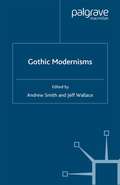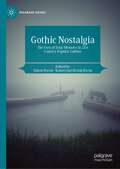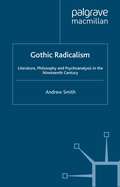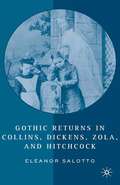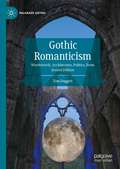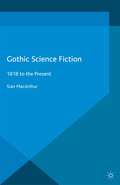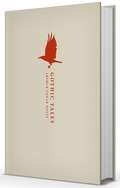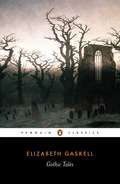- Table View
- List View
Gothic Literature (Edinburgh Critical Guides To Literature Ser.)
by Andrew SmithNew edition of bestselling introductory text outlining the history and ways of reading Gothic literature.This revised edition includes: A new chapter on Contemporary Gothic which explores the Gothic of the early twentieth century and looks at new critical developments An updated Bibliography of critical sources and a revised Chronology The book opens with a Chronology and an Introduction to the principal texts and key critical terms, followed by five chapters: The Gothic Heyday 1760-1820; Gothic 1820-1865; Gothic Proximities 1865-1900; Twentieth Century; and Contemporary Gothic. The discussion examines how the Gothic has developed in different national contexts and in different forms, including novels, novellas, poems, films, radio and television. Each chapter concludes with a close reading of a specific text – Frankenstein, Jane Eyre, Dracula, The Silence of the Lambs and The Historian – to illustrate ways in which contextual discussion informs critical analysis. The book ends with a Conclusion outlining possible future developments within scholarship on the Gothic.
Gothic Modernisms
by A. Smith J. WallaceThis is the first full length exploration of the relationship between Gothic fiction and Modernism in fiction and film. The Gothic's fascination with images of the fragmented self is echoed in the Modernist concern with the psyche and the paranoia of the everyday. The contributors explore how the Gothic influences a range of writers including James Joyce, D.H. Lawrence, Virginia Woolf, May Sinclair, Elizabeth Bowen and Djuna Barnes.
Gothic Nostalgia: The Uses of Toxic Memory in 21st Century Popular Culture (Palgrave Gothic)
by Simon Bacon Katarzyna Bronk-BaconThis book is an original and innovative study of how Gothic nostalgia and toxic memory are used to underpin and promote the ongoing culture wars and populist politics in contemporary popular culture. The essays collected here cover topics from the spectral to the ecological, deep fakes to toxic ableism, Mary Poppins to John Wick to reveal how the use of an imaginary past to shape the present, creates truly Gothic times that we can never escape. These ‘hungry ghosts’ from the past find resonance with the Gothic which speaks equally of a past that often not only haunts the present but will not let it escape its grasp. This collection will look at the confluence between various kinds of toxic nostalgia and popular culture to suggest the ways in which contemporary populism has resurrected ideological monsters from the grave to gorge on the present and any possibility of change that the future might represent.
The Gothic Novel and the Stage: Romantic Appropriations (Literary Texts and the Popular Marketplace)
by Francesca SagginiIn this ground-breaking study Saggini explores the relationship between the late eighteenth-century novel and the theatre, arguing that the implicit theatricality of the Gothic novel made it an obvious source from which dramatists could take ideas. Similarly, elements of the theatre provided inspiration to novelists.
The Gothic Novel and the Stage: Romantic Appropriations (Literary Texts and the Popular Marketplace #9)
by Francesca SagginiIn this ground-breaking study Saggini explores the relationship between the late eighteenth-century novel and the theatre, arguing that the implicit theatricality of the Gothic novel made it an obvious source from which dramatists could take ideas. Similarly, elements of the theatre provided inspiration to novelists.
The gothic novel in Ireland, c. 1760–1829 (Manchester University Press Ser. (PDF))
by Christina MorinA compelling account of the development of gothic literature in late-eighteenth and early-nineteenth century Ireland.
Gothic Pathologies: The Text, the Body and the Law
by D. PunterThis is a wide-ranging book about aspects of the Gothic, from classic texts such as Frankenstein and Wuthering Heights to contemporary fiction by Iain Banks, William Gibson and many others. It approaches the texts through looking at the opposition between the Gothic and the law, suggesting ways in which Gothic at all points produces transgression. It looks at horror fiction by, for example, Stephen King and Robert Bloch, as well as stories from China and Hong Kong, and suggests new ways in which contemporary literary and psychological theory might relate to and address the Gothic.
Gothic Peregrinations: The Unexplored and Re-explored Territories (Routledge Studies in Nineteenth Century Literature)
by Agnieszka Lowczanin Katarzyna MaleckaFor over two hundred years, the Gothic has remained fixed in the European and American imaginations, steadily securing its position as a global cultural mode in recent decades. The globalization of Gothic studies has resulted in the proliferation of new critical concepts and a growing academic interest in the genre. Yet, despite its longevity, unprecedented expansion, and accusations of prescriptiveness, the Gothic remains elusive and without a straightforward definition. Gothic Peregrinations: The Unexplored and Re-explored Territories looks at Gothic productions largely marginalized in the studies of the genre, including the European absorption of and response to the Gothic. This collection of essays identifies landmarks and ley lines in the insufficiently probed territories of Gothic scholarship and sets out to explore its unmapped regions. This volume not only examines Gothic peregrinations from a geographical perspective but also investigates how the genre has been at odds with strict demarcation of generic boundaries. Analyzing texts which come from outside the Gothic canon, yet prove to be deeply indebted to it, like bereavement memoirs, stories produced by and about factory girls of Massachusetts, and the Mattel Monster High franchise, this volume illuminates the previously unexplored fields in Gothic studies. The chapters in this volume reveal the truly transnational expansion of the Gothic and the importance of exchange – exchange now seen not only as crucial to the genre’s gestation, or vital to the processes of globalization, but also to legitimizing Gothic studies in the global world.
Gothic Peregrinations: The Unexplored and Re-explored Territories (Routledge Studies in Nineteenth Century Literature)
by Agnieszka Lowczanin Katarzyna MaleckaFor over two hundred years, the Gothic has remained fixed in the European and American imaginations, steadily securing its position as a global cultural mode in recent decades. The globalization of Gothic studies has resulted in the proliferation of new critical concepts and a growing academic interest in the genre. Yet, despite its longevity, unprecedented expansion, and accusations of prescriptiveness, the Gothic remains elusive and without a straightforward definition. Gothic Peregrinations: The Unexplored and Re-explored Territories looks at Gothic productions largely marginalized in the studies of the genre, including the European absorption of and response to the Gothic. This collection of essays identifies landmarks and ley lines in the insufficiently probed territories of Gothic scholarship and sets out to explore its unmapped regions. This volume not only examines Gothic peregrinations from a geographical perspective but also investigates how the genre has been at odds with strict demarcation of generic boundaries. Analyzing texts which come from outside the Gothic canon, yet prove to be deeply indebted to it, like bereavement memoirs, stories produced by and about factory girls of Massachusetts, and the Mattel Monster High franchise, this volume illuminates the previously unexplored fields in Gothic studies. The chapters in this volume reveal the truly transnational expansion of the Gothic and the importance of exchange – exchange now seen not only as crucial to the genre’s gestation, or vital to the processes of globalization, but also to legitimizing Gothic studies in the global world.
The Gothic, Postcolonialism and Otherness: Ghosts from Elsewhere
by T. KhairStarting with a re-examination of the role of the colonial/racial Other in mainstream Gothic (colonial) fiction, this book goes on to engage with the problem of narrating the 'subaltern' in the post-colonial context. It engages with the problems of representing 'difference' in lucid conceptual terms, with much attention to primary texts, and highlights the strengths and weaknesses of colonial discourses as well as postcolonialist attempts to 'write back.' While providing rich readings of Conrad, Kipling, Melville, Emily Brontë, Erna Brodber, Jean Rhys and others, it offers new perspectives on Otherness, difference and identity, re-examines the role of emotions in literature, and suggests productive ways of engaging with contemporary global and postcolonial issues.
Gothic Radicalism: Literature, Philosophy and Psychoanalysis in the Nineteenth Century
by A. SmithApplying ideas drawn from contemporary critical theory this book historicizes psychoanalysis through a new, and significant, theorization of the Gothic. The central premise is that the nineteenth-century Gothic produced a radical critique of accounts of sublimity and Freudian psychoanalysis. This book makes a major contribution to an understanding of both the nineteenth century and the Gothic discourse which challenged the dominant ideas of that period. Writers explored include Mary Shelley, Edgar Allan Poe, Robert Louis Stevenson and Bram Stoker.
Gothic Remixed: Monster Mashups and Frankenfictions in 21st-Century Culture
by Megen de Bruin-MoléThe bestselling genre of Frankenfiction sees classic literature turned into commercial narratives invaded by zombies, vampires, werewolves, and other fantastical monsters. Too engaged with tradition for some and not traditional enough for others, these 'monster mashups' are often criticized as a sign of the artistic and moral degeneration of contemporary culture. These hybrid creations are the 'monsters' of our age, lurking at the limits of responsible consumption and acceptable appropriation. This book explores the boundaries and connections between contemporary remix and related modes, including adaptation, parody, the Gothic, Romanticism, and postmodernism. Taking a multimedia approach, case studies range from novels like Pride and Prejudice and Zombies and The Extraordinary Adventures of the Athena Club series, to television programmes such as Penny Dreadful, to popular visual artworks like Kevin J. Weir's Flux Machine GIFs. Megen de Bruin-Molé uses these monstrous and liminal works to show how the thrill of transgression has been contained within safe and familiar formats, resulting in the mashups that dominate Western popular culture.
Gothic Remixed: Monster Mashups and Frankenfictions in 21st-Century Culture
by Megen de Bruin-MoléThe bestselling genre of Frankenfiction sees classic literature turned into commercial narratives invaded by zombies, vampires, werewolves, and other fantastical monsters. Too engaged with tradition for some and not traditional enough for others, these 'monster mashups' are often criticized as a sign of the artistic and moral degeneration of contemporary culture. These hybrid creations are the 'monsters' of our age, lurking at the limits of responsible consumption and acceptable appropriation. This book explores the boundaries and connections between contemporary remix and related modes, including adaptation, parody, the Gothic, Romanticism, and postmodernism. Taking a multimedia approach, case studies range from novels like Pride and Prejudice and Zombies and The Extraordinary Adventures of the Athena Club series, to television programmes such as Penny Dreadful, to popular visual artworks like Kevin J. Weir's Flux Machine GIFs. Megen de Bruin-Molé uses these monstrous and liminal works to show how the thrill of transgression has been contained within safe and familiar formats, resulting in the mashups that dominate Western popular culture.
Gothic Returns in Collins, Dickens, Zola, and Hitchcock
by E. SalottoLooking at the gothic in Victorian fiction, the development of cinema and Hitchcock's Vertigo , this book explores the contained or repressed desires of both characters and plots which defy direct representation, resulting in obsession, fetishism and displacement engendering a novel account of the way in which the gothic becomes internalized.
Gothic Romanced: Consumption, Gender And Technology In Contemporary Fictions
by Fred BottingThe dark, destructive and monstrous elements of gothic fiction have traditionally been seen in opposition to the rose-tinted idealism of Romanticism. In this ground-breaking study, Fred Botting re-evaluates the relationship between the two genres in order to plot the shifting alignments of popular and literary fictions with cultural theories, consumption and representations of science. Gothic Romancedtraces the history of gothic and romantic writings from the eighteenth and nineteenth centuries to the present day. It examines the ways in which these genres were aligned with the historical process of modernity - with the Gothic representing the negative aspects of vice and barbarism that accompanied the changing parameters of civilisation, while Romance clung on to traditional values, manners and feelings. The book demonstrates how these genres have evolved together alongside cultural shifts and postmodern theories, blurring the binary between the sacred and the profane. Botting considers Romance and the Gothic from Mary Shelley, Anne Rice and Alasdair Gray through to Alienand Star Trek. He manages a fluid and extensive exploration of generic boundaries, including gothic fiction, romantic poetry, literary pastiches, popular horror fiction, cyberpunk and science fiction.
Gothic Romanticism: Architecture, Politics, and Literary Form (Nineteenth-Century Major Lives and Letters)
by T. DuggettGothic Romanticism, winner of the 2010 MLA Prize for Independent Scholars, is a study of the relationship between British Romanticism and the Gothic Revival. Reading a wide range of canonical and raretexts, and spanning the Romantic discourses of architecture, politics, and literary form, the book recovers the collaborative project of Wordsworth, Coleridge, and Southeyfor a purified 'Gothic' poetry and a 'second Gothic' culture.
Gothic Romanticism: Wordsworth, Architecture, Politics, Form (Palgrave Gothic)
by Tom DuggettGothic Romanticism: Wordsworth, Architecture, Politics, Form offers a revisionist account of both Wordsworth and the politics of antiquarianism in the late eighteenth and early nineteenth centuries. As a historically-driven study that develops a significant critique and revision of genre- and theory-based approaches to the Gothic, it covers many key works by Wordsworth and his fellow “Lake Poets” Samuel Taylor Coleridge and Robert Southey. The second edition incorporates new materials that develop the argument in new directions opened up by changes in the field over the last decade. The book also provides a sustained reflection upon Romantic conservatism, including the political thought and lasting influence of Edmund Burke. New material places the book in wider and longer context of the political and historical forms seen developing in Wordsworth, and proposes Gothic Romanticism as the alternative line of cultural development to Victorian Medievalism.
Gothic Science Fiction: 1818 to the Present (Palgrave Gothic)
by S. MacArthurGothic Science Fiction explores the fascinating world of gothic influenced science fiction. From Frankenstein to Doctor Who and from H. G Wells to Stephen King, the book charts the rise of a genre and follows the descent into darkness that consumes it.
Gothic Shakespeares (Accents on Shakespeare)
by John Drakakis Dale TownshendReadings of Shakespeare were both influenced by and influential in the rise of Gothic forms in literature and culture from the late eighteenth century onwards. Shakespeare’s plays are full of ghosts, suspense, fear-inducing moments and cultural anxieties which many writers in the Gothic mode have since emulated, adapted and appropriated. The contributors to this volume consider: Shakespeare’s relationship with popular Gothic fiction of the eighteenth century how, without Shakespeare as a point of reference, the Gothic mode in fiction and drama may not have developed and evolved in quite the way it did the ways in which the Gothic engages in a complex dialogue with Shakespeare, often through the use of quotation, citation and analogy the extent to which the relationship between Shakespeare and the Gothic requires a radical reappraisal in the light of contemporary literary theory, as well as the popular extensions of the Gothic into many modern modes of representation. In Gothic Shakespeares, Shakespeare is considered alongside major Gothic texts and writers – from Horace Walpole, Ann Radcliffe, Matthew Lewis and Mary Shelley, up to and including contemporary Gothic fiction and horror film. This volume offers a highly original and truly provocative account of Gothic reformulations of Shakespeare, and Shakespeare’s significance to the Gothic. Contributors include: Fred Botting, Elizabeth Bronfen, Glennis Byron, Sue Chaplin, Steven Craig, John Drakakis, Michael Gamer, Jerrold Hogle, Peter Hutchings, Robert Miles, Dale Townshend, Scott Wilson and Angela Wright.
Gothic Shakespeares (Accents on Shakespeare #10)
by John Drakakis Dale TownshendReadings of Shakespeare were both influenced by and influential in the rise of Gothic forms in literature and culture from the late eighteenth century onwards. Shakespeare’s plays are full of ghosts, suspense, fear-inducing moments and cultural anxieties which many writers in the Gothic mode have since emulated, adapted and appropriated. The contributors to this volume consider: Shakespeare’s relationship with popular Gothic fiction of the eighteenth century how, without Shakespeare as a point of reference, the Gothic mode in fiction and drama may not have developed and evolved in quite the way it did the ways in which the Gothic engages in a complex dialogue with Shakespeare, often through the use of quotation, citation and analogy the extent to which the relationship between Shakespeare and the Gothic requires a radical reappraisal in the light of contemporary literary theory, as well as the popular extensions of the Gothic into many modern modes of representation. In Gothic Shakespeares, Shakespeare is considered alongside major Gothic texts and writers – from Horace Walpole, Ann Radcliffe, Matthew Lewis and Mary Shelley, up to and including contemporary Gothic fiction and horror film. This volume offers a highly original and truly provocative account of Gothic reformulations of Shakespeare, and Shakespeare’s significance to the Gothic. Contributors include: Fred Botting, Elizabeth Bronfen, Glennis Byron, Sue Chaplin, Steven Craig, John Drakakis, Michael Gamer, Jerrold Hogle, Peter Hutchings, Robert Miles, Dale Townshend, Scott Wilson and Angela Wright.
Gothic Tales (Oxford World's Classics)
by Arthur Conan Doyle'There was a rumour, too, that he was a devil-worshipper, or something of that sort, and also that he had the evil eye...' Arthur Conan Doyle was the greatest genre writer Britain has ever produced. Throughout a long writing career, he drew on his own medical background, his travels, and his increasing interest in spiritualism and the occult to produce a spectacular array of Gothic Tales. Many of Doyle's writings are recognised as the very greatest tales of terror. They range from hauntings in the polar wasteland to evil surgeons and malevolent jungle landscapes. This collection brings together over thirty of Conan Doyle's best Gothic Tales. Darryl Jones's introduction discusses the contradictions in Conan Doyle's very public life - as a medical doctor who became obsessed with the spirit world, or a British imperialist drawn to support Irish Home Rule - and shows the ways in which these found articulation in that most anxious of all literary forms, the Gothic.
Gothic Tales (Oxford World's Classics)
by Arthur Conan Doyle'There was a rumour, too, that he was a devil-worshipper, or something of that sort, and also that he had the evil eye...' Arthur Conan Doyle was the greatest genre writer Britain has ever produced. Throughout a long writing career, he drew on his own medical background, his travels, and his increasing interest in spiritualism and the occult to produce a spectacular array of Gothic Tales. Many of Doyle's writings are recognised as the very greatest tales of terror. They range from hauntings in the polar wasteland to evil surgeons and malevolent jungle landscapes. This collection brings together over thirty of Conan Doyle's best Gothic Tales. Darryl Jones's introduction discusses the contradictions in Conan Doyle's very public life - as a medical doctor who became obsessed with the spirit world, or a British imperialist drawn to support Irish Home Rule - and shows the ways in which these found articulation in that most anxious of all literary forms, the Gothic.
Gothic Tales (Oxford World's Classics)
by Arthur Conan Doyle'There was a rumour, too, that he was a devil-worshipper, or something of that sort, and also that he had the evil eye...' Arthur Conan Doyle was the greatest genre writer Britain has ever produced. Throughout a long writing career, he drew on his own medical background, his travels, and his increasing interest in spiritualism and the occult to produce a spectacular array of Gothic Tales. Many of Doyle's writings are recognised as the very greatest tales of terror. They range from hauntings in the polar wasteland to evil surgeons and malevolent jungle landscapes. This collection brings together over thirty of Conan Doyle's best Gothic Tales. Darryl Jones's introduction discusses the contradictions in Conan Doyle's very public life - as a medical doctor who became obsessed with the spirit world, or a British imperialist drawn to support Irish Home Rule - and shows the ways in which these found articulation in that most anxious of all literary forms, the Gothic.
Gothic Tales (Oxford World's Classics)
by Arthur Conan Doyle'There was a rumour, too, that he was a devil-worshipper, or something of that sort, and also that he had the evil eye...' Arthur Conan Doyle was the greatest genre writer Britain has ever produced. Throughout a long writing career, he drew on his own medical background, his travels, and his increasing interest in spiritualism and the occult to produce a spectacular array of Gothic Tales. Many of Doyle's writings are recognised as the very greatest tales of terror. They range from hauntings in the polar wasteland to evil surgeons and malevolent jungle landscapes. This collection brings together over thirty of Conan Doyle's best Gothic Tales. Darryl Jones's introduction discusses the contradictions in Conan Doyle's very public life - as a medical doctor who became obsessed with the spirit world, or a British imperialist drawn to support Irish Home Rule - and shows the ways in which these found articulation in that most anxious of all literary forms, the Gothic.
Gothic Tales (Penguin Classics)
by Elizabeth Gaskell Laura KranzlerElizabeth Gaskell's chilling Gothic tales blend the real and the supernatural to eerie, compelling effect. 'Disappearances', inspired by local legends of mysterious vanishings, mixes gossip and fact; 'Lois the Witch', a novella based on an account of the Salem witch hunts, shows how sexual desire and jealousy lead to hysteria; while in 'The Old Nurse's Story' a mysterious child roams the freezing Northumberland moors. Whether darkly surreal, such as 'The Poor Clare', where an evil doppelgänger is formed by a woman's bitter curse, or mischievous like 'Curious, if True', a playful reworking of fairy tales, all the stories in this volume form a stark contrast to the social realism of Gaskell's novels, revealing a darker and more unsettling style of writing.

